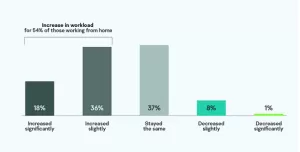How to Improve Team Collaboration When Some Employees Are Remote

Remote and hybrid teams can struggle to collaborate effectively. Often team members aren’t just far away physically, but temporally, too. Navigating various time zones can be a headache that causes real frustration at work. So it’s important to find ways to improve collaboration by making sure your entire team is on the same page. Read on to learn about a few ways you can do just that.
1. Align Your Strategy
There are many ways to support team collaboration, but strategy alignment is one of the most important. If different team members are operating with different priorities, it can cause serious conflict. And conflict can result in your team consistently underperforming and underdelivering on key performance indicators. As a team leader, you need to make sure everyone is working toward the same goals.
Strategy alignment is all about making sure your team’s projects and tasks ladder up to your primary business goals. This requires a clear understanding of what those goals are and what values you’re not willing to compromise to realize them. If you see that team members are disagreeing about organizational priorities, your team is likely out of alignment.
To align your team, hold an all-hands meeting to clarify your group’s purpose and identify core values. Then articulate a clear vision with KPIs to help measure your progress toward achieving that vision. With tasks assigned and milestones in place, your team can move toward your objectives in strategic alignment. Keep in mind that this foundational aspect of team building may take time, but it’s well worth the effort.
2. Use Collaboration Tools
Aligning your strategy and clarifying goals can give your team a burst of momentum. But without the proper tools to facilitate that enthusiasm, it can quickly burn out. You can create all the KPIs in the world to work toward, but it won’t matter if you don’t have a good way to measure them. Set your team up for success by leveraging online collaboration tools to keep track of your progress.
Project management tools like ClickUp, Trello, and Monday.com are ideal for facilitating and monitoring your team’s collaborative efforts. They provide visual representations of workflows so everyone has a clear picture of what needs to get done, by whom, and when. Anyone on the team, wherever they’re located, can see what deliverables they’re responsible for and who gets them next.
While project management tools provide spaces for team members to discuss project tasks, they’re unlikely to meet all your organization’s communication needs. Tools like Zoom and Microsoft Teams let you host online video meetings that bring together team members from around the globe. Instant messaging platforms like Slack and Google Chat enable colleagues to get quick answers to questions that might languish in an email.
3. Build Up Team Culture
Teams without a strong culture can struggle with motivation and maintaining interest in their work. And there’s no denying that remote teams are at risk of producing a stale culture. Since they have no shared physical environment, there are fewer organic opportunities for spontaneous interaction. In person, it’s easy to walk to someone’s desk to chat or invite them to grab lunch; in dispersed teams, not so much. Therefore, remote teams need to focus on actively building their culture.
Hosting non-work Zooms is a great way for team members to get to know each other better. With their beverage of choice in hand, colleagues can share funny stories or discuss topics of mutual interest, becoming acquainted on a deeper level. You can also take advantage of online games to foster a more playful dynamic. Jackbox games are famously entertaining and easy to pick up for just about any group. And don’t underestimate the team-building potential of Slack — dedicated channels for sharing pet photos and silly memes are powerful camaraderie boosters.
To go a step further, your team could even plan a get-together in a central location. For disparate groups scattered around the world, a meetup is a great opportunity to travel somewhere fun and interesting. Meeting in person is another way to foster team building and strengthen the bonds among co-workers. With stronger connections between individuals, your whole team will collaborate more effectively.
4. Stay Aware of Time Zones
As your team continues to grow, it’s likely that you’ll be working with people in different time zones. That can mean scheduling conflicts, especially when it comes to meetings. Remember that someone might normally be having dinner when you want to host an all-hands gathering.
Do your best to keep track of the various time zones your team members are operating in. Schedule meetings and deadlines for appropriate hours with these times in mind. Take advantage of time zone calculators to avoid scheduling errors and inequities. Using plugins that display the various time zones conveniently on your browser will keep this factor top of mind
In addition, consult each individual regarding their availability — don’t just assume when someone will be free. One team member might love to wake up early in your time zone while another across the world is a night owl. Asking team members about their work style/timing preferences will help you avoid scheduling conflicts and resentment. It will also demonstrate your respect for your employees’ time and autonomy.
Crowdsourcing Input for Improved Team Collaboration
There are many ways to help improve remote team collaboration, some practical and some cultural. Do your best to establish clear expectations with your team, but also give them opportunities to express themselves. Field input on team collaboration and communication practices from employees and take their opinions into consideration. In the end, as team leader, you’ll make the final calls on any changes in approach. But your employees will appreciate your efforts to help everyone to work better together.












